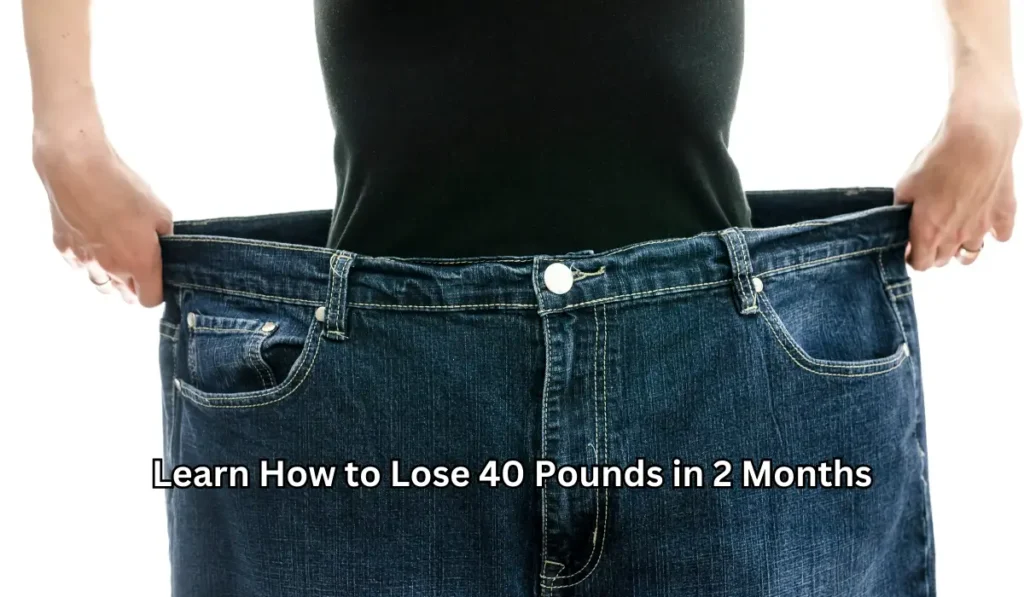
Learn How to Lose 40 Pounds in 2 Months
Are you tired of carrying around excess weight and feeling self-conscious about your appearance? Losing 40 pounds in just 2 months may seem like a lofty goal, but with the right approach and mindset, it’s definitely achievable.
In this blog post, we will be sharing a step-by-step guide on how to lose 40 pounds in 2 months. We understand that losing weight can be challenging, especially when you’re juggling a busy work or home life. That’s why we’ve created a comprehensive guide that is easy to follow and tailored to your lifestyle.

You’ll discover everything from the importance of setting realistic goals to creating a personalized meal plan and exercise routine that works for you. We’ll also provide you with tips on how to stay motivated and overcome any obstacles you may encounter on your weight loss journey.
So if you’re ready to take control of your health and transform your body, keep reading to learn more!
The Importance of Losing Weight
Losing weight can have numerous benefits for your physical and mental health. Here are some of the key reasons why weight loss is important:
- Reduced risk of chronic diseases: Carrying excess weight increases your risk of developing chronic diseases such as heart disease, type 2 diabetes, and certain cancers. Losing weight can significantly reduce your risk of developing these conditions.
- Improved energy and mobility: Losing weight can make it easier to move around and complete everyday tasks, which can improve your quality of life. You may also notice that you have more energy throughout the day.
- Better sleep: Losing weight can improve the quality of your sleep, which can have a positive impact on your overall health and well-being.
- Increased confidence and self-esteem: Achieving your weight loss goals can boost your self-confidence and self-esteem, which can have a positive impact on your mental health.
- Longer lifespan: Studies have shown that maintaining a healthy weight can increase your lifespan, allowing you to live a longer, healthier life.
Step 1: Calculate Your Daily Calorie Needs
The first step in how to lose 40 pounds in 2 months is to calculate your daily calorie needs. This will give you an idea of how many calories you should be consuming each day in order to achieve your weight loss goals.
To calculate your daily calorie needs, you will need to determine your Basal Metabolic Rate (BMR) and Total Daily Energy Expenditure (TDEE).
- Basal Metabolic Rate (BMR): This is the number of calories your body burns at rest, just to keep your organs functioning. To calculate your BMR, you can use an online one rep max calculator that takes into account your age, height, weight, and gender.
- Total Daily Energy Expenditure (TDEE): This is the total number of calories your body burns each day, taking into account your BMR as well as your activity level. To calculate your TDEE, you can multiply your BMR by an activity factor that takes into account your daily physical activity level.
Once you have calculated your TDEE, you will have a good idea of how many calories you need to consume each day in order to maintain your current weight. In order to lose weight, you will need to create a calorie deficit by consuming fewer calories than your TDEE. A safe and sustainable calorie deficit is typically around 500-1000 calories per day, which can result in a weight loss of 1-2 pounds per week.
Read about Does Pre Workout Break a Fast
Step 2: Create a Calorie Deficit
How to reduce your calorie intake
Creating a calorie deficit is essential for losing weight, and the most effective way to do this is by reducing your calorie intake. However, it’s important to do this in a way that is sustainable and healthy, rather than relying on fad diets or extreme calorie restrictions.
One simple way to reduce your calorie intake is by cutting back on high-calorie, low-nutrient foods such as processed snacks, sugary drinks, and fast food. These types of foods are often high in calories and low in essential nutrients, which can make it difficult to feel full and satisfied.
Instead, focus on incorporating more whole foods into your diet such as fruits, vegetables, whole grains, and lean proteins. These types of foods are typically lower in calories and higher in nutrients, which can help you feel full and satisfied while still creating a calorie deficit.
Tips for healthy food choices
When trying to lose weight, it’s important to focus on making healthy food choices that provide your body with the nutrients it needs to function properly. Here are some tips for choosing healthy foods:
- Opt for nutrient-dense foods: Choose foods that are high in nutrients such as vitamins, minerals, and fiber, while also being relatively low in calories. Examples include leafy greens, berries, whole grains, and lean proteins.
- Choose foods that are filling: Foods that are high in fiber, protein, and water content tend to be more filling, which can help you feel satisfied and avoid overeating. Examples include beans, lentils, nuts, and seeds.
- Avoid processed foods: Processed foods are often high in calories, sugar, and unhealthy fats, and low in essential nutrients. Try to avoid foods such as candy, chips, and sugary drinks.
- Cook at home: Cooking your own meals allows you to have more control over the ingredients and portion sizes, which can help you make healthier choices.
Importance of tracking your meals
Tracking your meals is an important tool for weight loss, as it can help you stay aware of the number of calories you’re consuming each day. There are several ways to track your meals, including using a food diary, mobile app, or online tracker.
When tracking your meals, it’s important to be honest and accurate about the portion sizes and ingredients you’re using. This can help you identify areas where you may be consuming more calories than you realize, and make adjustments as needed.
Tracking your meals can also help you identify patterns and trends in your eating habits, which can be useful for making changes and setting goals. For example, if you notice that you tend to overeat at dinner, you can make adjustments such as eating a larger lunch or incorporating more filling foods into your dinner.

Step 3: Exercise Regularly
Exercise is an essential component of any weight loss plan, as it helps to increase your calorie burn, build muscle, and improve your overall health and well-being. Here are some tips for incorporating regular exercise into your weight loss plan:
- Choose activities you enjoy: The key to sticking with an exercise routine is to choose activities that you enjoy and that fit into your lifestyle. This could include anything from walking, jogging, swimming, biking, or participating in group fitness classes.
- Aim for at least 30 minutes per day: The American Heart Association recommends getting at least 150 minutes of moderate-intensity exercise per week, which translates to about 30 minutes per day. This could be broken up into shorter sessions throughout the day if needed.
- Mix up your routine: Incorporating a variety of exercises into your routine can help prevent boredom and keep you motivated. Try different types of cardio, strength training, and flexibility exercises to keep things interesting.
- Increase intensity gradually: If you’re new to exercise, it’s important to start slowly and gradually increase the intensity and duration of your workouts. This can help prevent injury and ensure that you’re able to stick with your routine.
- Get support: Finding a workout buddy or joining a fitness group can provide motivation, accountability, and support as you work towards your weight loss goals.
- Be active throughout the day: In addition to structured exercise, it’s important to stay active throughout the day by taking breaks to stretch, standing up and moving around regularly, and incorporating more physical activity into your daily routine.
By incorporating regular exercise into your weight loss plan, you can increase your calorie burn, build muscle, and improve your overall health and well-being. With a little creativity and motivation, you can find ways to stay active and make exercise a regular part of your lifestyle.
Read about Tips for Achieving a 400lb Bench Press
Step 4: Get Enough Sleep
Getting enough sleep is an often overlooked but important component of any weight loss plan. Lack of sleep has been linked to increased appetite, cravings, and weight gain while getting enough sleep can help to regulate hormones that control hunger and metabolism. Here are some tips for improving your sleep habits:
- Aim for 7-9 hours per night: Most adults need between 7-9 hours of sleep per night to function at their best. Make sleep a priority by setting a regular bedtime and waking time, and avoiding electronics and other stimulating activities before bed.
- Create a sleep-friendly environment: Make your bedroom a comfortable, quiet, and cool place to sleep. Use blackout curtains or an eye mask to block out light, and avoid using electronics in bed.
- Limit caffeine and alcohol: Caffeine and alcohol can disrupt sleep and should be avoided or limited in the evening hours.
- Practice relaxation techniques: Activities such as meditation, deep breathing, or gentle stretching can help to calm your mind and prepare your body for sleep.
- Get regular exercise: Regular exercise can improve the quality of your sleep and help you fall asleep more easily. However, it’s important to avoid exercising too close to bedtime, as this can interfere with sleep.
- Seek medical advice if needed: If you’re experiencing sleep difficulties or sleep disorders such as sleep apnea, it’s important to seek medical advice and treatment.
By prioritizing sleep and making changes to your sleep habits, you can improve your overall health and well-being, and support your weight loss efforts. Getting enough sleep can help you feel more energized, focused, and motivated to make healthy choices throughout the day.
Also read info about How to Buy Dianabol here!

Step 5: Stay Motivated and Accountable
Staying motivated and accountable is key to achieving your weight loss goals. Here are some tips for staying motivated and accountable:
- Set realistic goals: Set realistic and achievable goals for yourself, and break them down into smaller, more manageable steps. This can help you stay motivated and avoid feeling overwhelmed.
- Find support: Surround yourself with people who support your weight loss goals and who can provide encouragement and accountability. This could include family members, friends, or a support group.
- Celebrate your successes: Celebrate your successes along the way, no matter how small. Recognizing your progress can help you stay motivated and focused on your goals.
- Keep a journal: Keeping a journal can help you track your progress, identify patterns, and stay accountable to yourself. Write down your goals, your progress, and any challenges you encounter along the way.
- Reward yourself: Set up a system of rewards for yourself when you achieve certain milestones or goals. This can help motivate you to keep going and stay on track.
- Don’t give up: Weight loss can be challenging, and it’s important to remember that setbacks and obstacles are a normal part of the journey. Don’t give up if you have a bad day or week – instead, use it as an opportunity to learn and grow.
By staying motivated and accountable, you can achieve your weight loss goals and maintain a healthy lifestyle for the long term. Remember to be kind to yourself, and celebrate your successes along the way. With a positive mindset and the right support, anything is possible.
Conclusion: So, How to Lose 40 Pounds in 2 Months?
Losing 40 pounds in just 2 months may seem like a daunting goal, but with the right approach and mindset, it’s definitely achievable. By following the steps outlined in this guide, including calculating your daily calorie needs, creating a calorie deficit, exercising regularly, getting enough sleep, and staying motivated and accountable, you can create a sustainable and effective weight loss plan.
Remember that weight loss is not a one-size-fits-all approach, and it’s important to find what works best for you and your lifestyle. Be patient and kind to yourself, and celebrate your successes along the way. With dedication, perseverance, and the right support, you can achieve your weight loss goals and maintain a healthy lifestyle for the long term.
